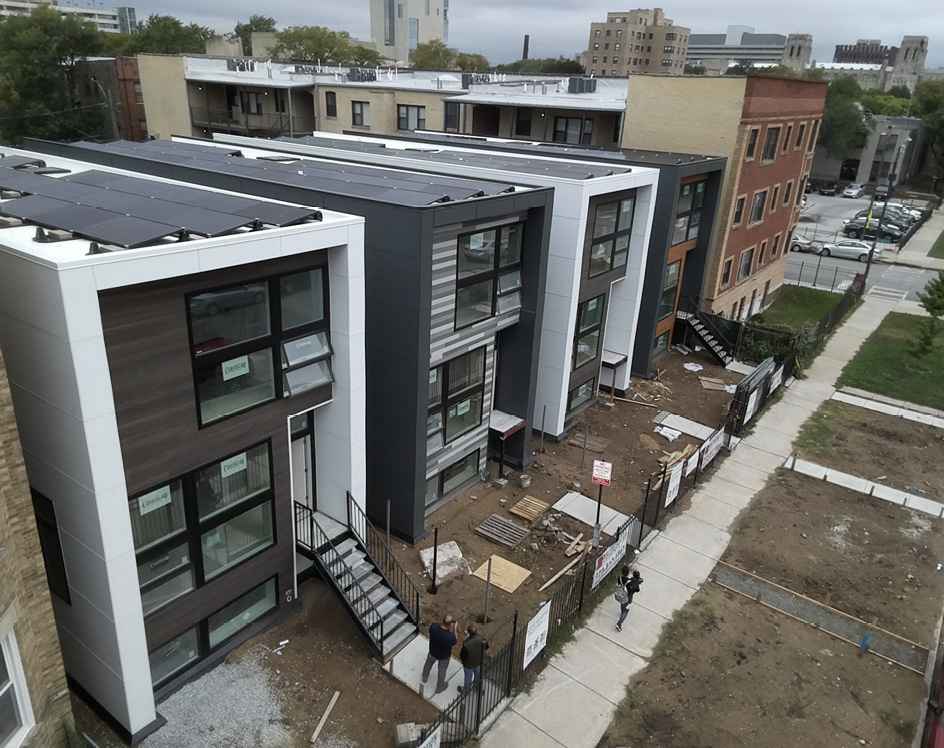
[Photo: Courtesy of Beals & Associates]
New construction of modern, sustainable, and healthy homes is happening in some unexpected places in Chicago. “We’re very focused on using merchant builder capabilities to bring affordable green homes to Chicago’s neighborhoods, particularly on the South Side,” says Benjamin Van Horne, founder of Greenline Homes. Six new LEED-certified, all-electric homes will soon call the 6100 block of Ellis Avenue in Chicago’s Woodlawn neighborhood home; one was complete in early fall, and more are on the way in Woodlawn as well as in the Bronzeville neighborhood.
“There’s a false assumption by a lot of builders that you can build lower quality on the South Side and people won’t notice, but the opposite I’ve found is true,” Van Horn says, noting the demand for comfortable and efficient housing in often overlooked neighborhoods. “Part of building a quality home we’ve learned is also building a highly durable and highly energy-efficient home. We came to green building not just through the desire to build a quality home, but also to add to the affordability of the home.” Houses like these add up to long-term reduced energy costs as well as environmental benefits for families living there.
Greenline Homes is committed to building all-electric homes with solar potential. “Going all electric is a commitment to mitigate climate change,” Van Horn says. The company also emphasizes development without displacement and opportunities for moderate-income, first-time homebuyers.
Just 10 homes in the last year have had Solar PV installed on spec by the developer in Cook County, most of which are Greenline’s Homes, according to Wayne Beals, managing broker for Beals & Associates. “Greenline’s homes are the only homes that utilize electricity for heating and eliminate natural gas as a fuel source,” he says, adding that supply is limited and, as a result, the houses are typically sold before they’re even constructed. “I think this demand will grow as consumers start to better understand why these homes are just better to live in,” Beals says. “They’re more comfortable, they’re quieter, they’re more durable, and they cost less to operate. Basically, we can’t build them fast enough, and as locations expand to neighborhoods, the potential market will grow rapidly.”
SEE ALSO: Chicago is One of the Greenest Cities in the World
It’s no secret that Chicago has a lot of neighborhoods that are increasingly difficult for middle class people to afford. “At the same time, there’s a lot of vacant land in relatively high amenity, transit-accessible neighborhoods in the South Side where it makes perfect sense to build houses,” Van Horn says. “That market disparity is not being resolved as quickly as it could be.” Greenline aims to fill the void in Chicago where there are few new construction homes in the $350–450,000 range. “People who are looking for a new construction home in that range either don’t have an option in the city or have to move to far out neighborhoods or the suburbs. We’re trying to fill that gap.”
Beals says Greenline Homes maintain simple comforts without compromising on luxury. “It’s an exceptionally well designed home—both inside and outside of the walls—that’s easier to maintain than a less sustainable, new construction home,” he says. Technology in the houses is serviceable by most local maintenance contractors and gas is eliminated, further simplifying the mechanical design and eliminating the potential for gas leaks and carbon dioxide poisoning.
And while it might not sound that glamorous, Van Horn says the HVAC system is truly exciting. The houses incorporate Mitsubishi air source heat pumps with variable refrigerant flow for superb energy efficiency and comfort. “It runs constantly, keeping the air flowing and keeping you more comfortable. You set it at the temperature you like and you forget it and you’re more comfortable all the time,” he says, as compared to traditional heating and cooling that shuts off and turns back on in extremes.
What’s most exciting about these construction projects, though, may simply be what they mean for the future of single-family homes in the city, Beals says. “Greenline is building a home that utilizes some tried and tested best practices like air sealing, cellulose insulation, air to air heat pumps, and net metering to achieve a result that wasn’t previously achieved in a Midwest climate—a 100% renewably powered home,” he says. “And they’re doing this in a market, Woodlawn, that demands cost controls not needed in other neighborhoods. Bottom line, they’re putting Woodlawn on the map as a neighborhood that sustainably minded consumers notice when shopping for a home.”
Houses like these are attainable, sustainable, and can work anywhere in Chicago, Beals says. “Consumers are taking notice of the carbon and economic advantages of these homes, and this will cause other builders to have to consider sustainability very seriously moving forward.”
FILLING A VOID
“The need is for high-quality, new construction homes within high-amenity, highly transit-accessible neighborhoods in Chicago,” says Benjamin Van Horn, founder of Greenline Homes.
